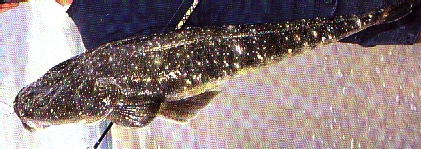
Dusky Flathead
(Platycephalus Fuscus)
 |
Common Names
The Dusky Flathead or Dusky is also known as the Estuary Flathead, Flattie or Lizard.
Description
The Dusky Flathead is the largest member of the family which contains more than 30 species. The Dusky Flathead has the characteristic flattened body, broad spade-line head, large mouth and fine teeth. It also has a set of fine sharp spines covered in a mildly venomous mucus which are located on the gill cover. The color is extremely variable, though ranges from a very light sandy/fawn with darker bars, and the belly is always creamy, creamy-yellow, or white in color.
Size
Duskies are the giants of the Flathead clan. Occasionally they will reach 1.5 metres in length and 10.0 kilos in weight, however, most caught usually weigh from 0.5-6.0 kilos.
Habitat
The Duskies are an estuarine and inshore species found off the east coast of Australia. They prefer tidal river estuaries, saltwater lakes, bays and inshore sand patches. They favour mud or sand bottoms, but occasionally can be found over rock or gravel.

Feeding
Dusky Flathead are know to ambush their prey, though they can also be scavengers. They lie camouflaged on the seabed and wait until some prawns, shrimp, crab, octopus or small fish come past before striking.
Fishing Techniques
Dusky Flathead may be fished for in a variety of ways. Many are taken on bottom-fished baits of small live paddy mullet or herring, dead mullet, pilchards, white bait, garfish, tailor, tuna. The bait is retrived slowly over the seabed, or by using the tide and current to keep the rig moving. They can also be taken on a small-medium size metal spoon, such as wobblers, tiger, minnows, etc. Many are taken with rubber-tail jigs. Flathead will use the tide and current to their advantage when feeding, and will usually choose to lie close to an abundant supply of food, in drop-offs and gutters. Tackle needed include 1/0-5/0 long-shank hooks and 3.0-10.0 kilo fishing line.
Eating
Duskies rate highly among the table fish, and have firm, white flakey flesh, which tends to be slightly drier in the larger fish.
Bag Limit
New South Wales all species 20 per day,Western Australia all species 4 per day.
Legal Size
Victoria all species 25cm,New South Wales sand and tiger only 33cm,Tasmania 30cm,Western Australia all species 30cm,Queensland all species 30cm.
 |
 |